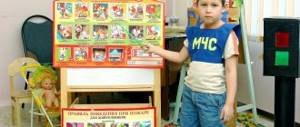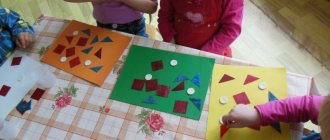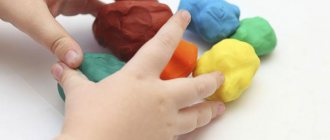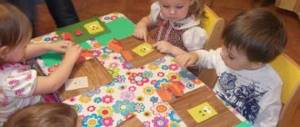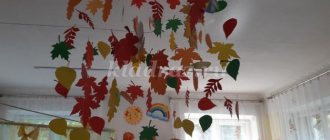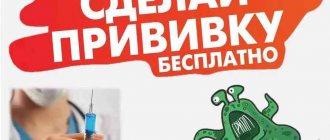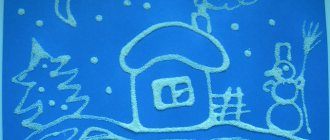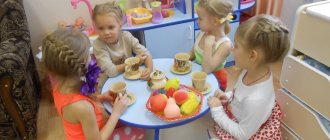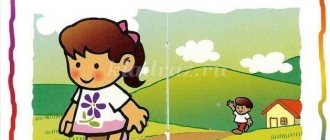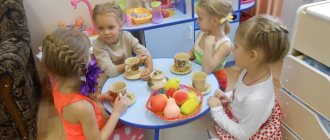Direction "Physical development". Second junior group (from 3 to 4 years old)
Educational field "Health"
The content of the educational field “Health” is aimed at achieving the goals of protecting children’s health and forming the basis of a culture of health through solving the following tasks:
- maintaining and strengthening the physical and mental health of children;
- education of cultural hygienic skills;
- formation of initial ideas about a healthy lifestyle.
Preservation and strengthening of children’s physical and mental health
Continue to strengthen and protect the health of children, create conditions for systematic hardening of the body, formation and improvement of basic types of movements.
Carry out constant monitoring of the development of correct posture.
Under the guidance of medical personnel, carry out a set of hardening procedures using various natural factors (air, sun, water).
Ensure optimal temperature conditions in the room and regular ventilation.
Teach children to wear lightweight clothing indoors. Ensure their exposure to air in accordance with their daily routine.
Do morning exercises every day for 5-6 minutes. If conditions exist, organize swimming lessons for children.
Education of cultural and hygienic skills
Improve cultural and hygienic skills, develop the simplest skills of behavior while eating and washing.
Teach children to take care of their appearance. Continue to develop the ability to use soap correctly, carefully wash your hands, face, ears; Wipe yourself dry after washing, hang the towel back, use a comb and a handkerchief.
Develop basic table behavior skills: correctly use tablespoons, teaspoons, forks, and napkins; do not crumble bread, chew food with your mouth closed, do not talk with your mouth full,
Formation of initial ideas about a healthy lifestyle
To develop children’s ability to distinguish and name sense organs (eyes, mouth, nose, ears), to give an idea of their role in the body and how to protect and care for them.
Give ideas about healthy and unhealthy foods; about vegetables and fruits, dairy products that are beneficial to human health.
To give an idea that morning exercises, games, and physical exercises cause a good mood; With the help of sleep, strength is restored.
Introduce children to exercises that strengthen various organs and systems of the body. Give an idea of the need for hardening.
Give an idea of the value of health; create a desire to lead a healthy lifestyle.
Develop a caring attitude towards your body, your health, and the health of other children.
Develop the ability to report well-being to adults, avoid situations that are harmful to health, and recognize the need for treatment.
To develop the need for hygiene and neatness in everyday life.
Educational field "Physical education"
The content of the educational field “Physical Education” is aimed at achieving the goals of developing children’s interest and value attitude towards physical education, harmonious physical development through solving the following specific tasks:
- development of physical qualities (speed, strength, flexibility, endurance and coordination);
- accumulation and enrichment of children’s motor experience (mastery of basic movements);
- formation in pupils of the need for
motor activity and physical improvement.
Development of physical qualities, accumulation and enrichment of motor experience
Develop the ability to walk and run freely, without shuffling your feet, without lowering your head, while maintaining cross-coordination of the movements of your arms and legs. Learn to act together. To develop the ability to form a column one at a time, in a line, in a circle, to find one’s place in formations.
To develop the ability to maintain correct posture in sitting, standing, in motion, and when performing exercises in balance.
Develop the ability to follow basic rules, coordinate movements, and navigate in space.
Continue to develop various types of movements, improve basic movements. Develop climbing and crawling skills; dexterity, expressiveness and beauty of movements.
Introduce more complex rules into games with changing types of movements.
Develop the ability to push off energetically with both legs and land correctly when jumping from a height, in place and moving forward; take the correct starting position in standing long and high jumps; in throwing sandbags and balls with a diameter of 15-20 cm.
Strengthen the ability to energetically push balls away when rolling and throwing; catch the ball with both hands at the same time.
Learn to grip the bar while climbing. Strengthen the ability to crawl.
Formation of the need for physical activity and physical improvement
Encourage children to participate in cooperative games and physical activities.
Foster interest in physical exercise, teach how to use physical education equipment in your free time.
To promote the formation in children of positive emotions and activity in independent motor activities.
To develop the desire and ability to ride a sled, tricycle, or ski.
Develop the ability to independently mount, ride, and dismount a tricycle.
Develop the ability to put on and take off skis, walk on them, and put skis in place.
Develop the ability to respond to signals “run”, “catch”, “stop”, etc.; follow the rules in outdoor games.
Develop independence and creativity when performing physical exercises and playing outdoor games. Organize outdoor games with rules.
Encourage children to play independently with wheelchairs, cars, carts, bicycles, balls, balls.
Abstract of GCD for physical education in the 2nd junior group of kindergarten
Summary of an open plot GCD using non-standard physical education equipment for physical education in the II junior group
Topic: “In search of Kolobok”
Author: Natalya Anatolyevna Kichigina, teacher of MADOU No. 18 “Kindergarten “Ladushki”, Gai, Orenburg region. Description. This open educational activity was conducted by me as a final lesson on the topic of self-education “Use of non-standard physical education equipment in a preschool educational institution” and as part of the certification work for the highest qualification category. Aids: — Visual: sports equipment: massage track, “stumps” — 5 pieces; pictures: hare, wolf, bear, fox; hut; toys: Kolobok, Grandmother; samovar; dish with treats for children. — Verbal: riddles; wellness massage “Good morning”. — Musical: musical game “The Fox and the Hares”; — ICT equipment: music center. Goal: harmonious physical development of children. Objectives: Educational objectives: - increase the motor activity of children; — teach children to correlate movements with text; — promote the formation of coordination of movements; Developmental tasks: - develop the physical qualities of children; - develop in children the skills of expressive and emotional transmission of playful and fairy-tale images; — improve the ability to guess riddles based on the plot of educational activities. Educational objectives: - cultivate a sense of collectivism; - promote the manifestation of positive emotions; - cultivate desire and interest in physical education and sports. Health objectives: - prevention of flat feet using different types of walking; — formation of correct breathing when performing breathing exercises; — influence biologically active points using different types of healing massage. Children enter the hall one after another. The teacher invites the children to greet each other and guests and have a “Good morning” wellness massage. Wellness massage “Good morning”
Good morning (Spread your arms to the sides)
Smile quickly And today the whole day will be more fun!
(Clap their hands)
We will stroke our forehead, nose and cheeks
(Do exercises according to the text)
We will be beautiful, like flowers in the garden.
(Gradually raise their hands up, performing “flashlights”)
Let’s rub our palms Stronger, stronger,
(Perform movements according to the text)
And now let’s clap Bolder, bolder.
(Clap their hands)
Now we'll rub our ears And save our health
(Rub our ears)
Let's smile again Let's all be healthy!
(Raise their hands up) Educator: - Guys, I suggest you go to a fairy tale. You are ready? (Children's answers)
We will walk along the path and find a good fairy tale. The children stood up one after another, everyone walked merrily. (Walking one after another around the hall)
Let's go in a half-squat, maybe we'll find a fungus
(Walking in a half-squat)
Let's stand together on our tiptoes, And let's stretch a little.
(Walking on toes)
We will walk again, It’s good for us to walk.
(Regular walking)
But it's time to hurry up, It's time to start the fairy tale.
(Easy jogging)
Again we walk together, Raise our hands to the top
(Walking one after another, breathing exercises)
Let’s all approach the house Let’s begin a good fairy tale.
(They approach the house) Educator: - So, we found ourselves in a fairy tale. Let’s try to guess what kind of fairy tale this is: Round side, ruddy side Rolled…. (Kolobok) Educator: -Well done, guys! Look, a grandmother is sitting near the hut and crying bitterly. She lost Kolobok. Guys, let's help Grandma find and return Kolobok. Let's hit the road! Children go out into the clearing and meet a fairy-tale character - a hare. Educator: -Oh, guys, someone is hiding here. Let's try to guess: Long ear, ball of fluff, Jumps deftly, loves carrots. (Bunny) - That's right, guys, it's a bunny. Let's teach the bunny to do exercises in order to become strong and dexterous. Children perform the musical and rhythmic composition “Fun Exercise”
Educator: -Well done, guys! We have now become strong and dexterous and can continue to go in search of Kolobok. Children meet a fairy tale character - a wolf. Educator: -Guys, let's go on in search of Kolobok. Is someone hiding here? Let's guess: Who walks around angry and hungry in the cold winter. (Wolf) - That's right - it's a wolf. To find Kolobok, the wolf invites us to follow in his footsteps. Children follow each other along a massage path with footprints.
Educator: -Well done, everyone coped with the wolf’s task. We continue our search for Kolobok. Guys, look, someone is meeting us here. Let's get a look! Clubfoot and big, He sleeps in a den in winter. He loves pine cones, he loves honey, Well, who can name it? (Bear) - Bear has prepared a task for us. He invites us to go through the stumps. Children step over the “stumps” with their legs raised high.
-What a great fellow you are, you overcame almost all the obstacles.
Oh, someone's hiding here. Let's see who it is? (the teacher takes out the fox). Yes, it's a fox! -Guys, our fox is somewhat depressed. Let's make the fox laugh and play with her, maybe then she will give us Kolobok. But first we need to turn into bunnies. One, two, turn around and turn into a rabbit! Children turn into bunnies and an active musical game “The Fox and the Hares” and breathing exercises are performed.
- The fox gives us Kolobok for our fun and interesting game.
Thank you, fox. Children "Bunnies" turn into guys. They take Kolobok and return him to Grandma. Educator: - Thank you guys for helping the little bun return home. Educator: -Guys, let's remember our journey. To sum up the GCD, the children answer the questions: What fairy tale did you visit? Who did you meet along the way? What did you do with the bunny? What did they do with the wolf? What did you do with the bear? What about the fox? Educator: - Oh, guys, while we were talking, grandma baked us a treat. (treats are distributed to the children) To the music, the children leave the hall.
We recommend watching:
Summary of OOD on speech development in the second junior group of a preschool educational institution Summary of a comprehensive visual lesson in the second junior group on the topic: Spring
Similar articles:
Physical education lesson in the 2nd junior group. Abstract
Summary of GCD in the 2nd junior group on the topic: Autumn
